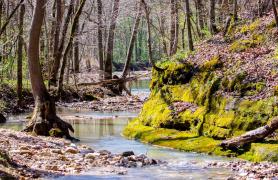Got a question for Ask MDC? Send it to AskMDC@mdc.mo.gov or call 573-522-4115, ext. 3848.
Q: My granddaughter found a shed antler. What can you tell us about the age of the deer that dropped it?
Antlers are not an accurate way to judge a deer’s age. Though the antlers produced by an individual deer tend to increase in size each year, there is too much overlap in antler size between age classes to be able to say with certainty what the age of the animal was.
However, other information can be learned from examining a shed. For example, most of Missouri’s bucks retain their antlers through hunting season. So, the fact that you found this antler is a sign this buck may have survived the hunting season and will be alive in the spring — if he survives winter, predation, or a vehicle strike. Shed antlers also can help reveal the fitness of a buck. If the base is rounded outward or convex, that’s a good sign of health. If the shed antler is concave and pitted, that’s a sign of injury, stress, or nutritional deficits. A healthy buck’s antler is dense, well-mineralized, and feels heavy for its size. A lighter-weight antler indicates the buck was struggling to stay fit. If you find an antler with a portion of the skull plate attached, that’s an indication the animal may have suffered a brain abscess — an infection that can erode the bone around the antler’s base. Also, fitter bucks hold onto their antlers longer. So, a shed lost in December or early January is not a promising sign; a shed lost in April or May suggests the animal was able to maintain good health for a longer period.
Q: Where are the best places to view snow geese in Missouri?
Snow geese movements are not easy to predict. As waterways freeze and thaw, flocks of these highly mobile waterfowl move from one location to another. However, for people willing to travel, Missouri’s best predictable snow goose experience is Loess Bluffs National Wildlife Refuge (NWR) in Holt County as birds seasonally move through the Midwest (short.mdc.mo.gov/4NQ).
While concentrations of snow geese can build in mid- to late-November, more birds use the refuge in the spring. As the landscape begins to thaw in mid-February, the area becomes a mecca for large concentrations of migratory birds attracted to a diversity of habitats, including lakes, farm fields, grasslands, freshwater marshes, and the nearby Missouri River.
Capable of hosting millions of snow geese at a time, Loess Bluffs NWR is located between two major migratory bird corridors: the Central and Mississippi flyways. For visitors, a driving route around the entire refuge offers great viewing opportunities. Snow geese begin to arrive in mid-February, peaking in mid-March.
By getting there before sunrise, birdwatchers increase the chances of seeing the geese fly out to feast on waste grain in nearby agricultural fields. The birds come and go throughout the morning. But by mid-day they can be concentrated on the wetlands. The birds then fly out again in late afternoon and return around sunset.
Southeast Missouri is another great option for spotting snow geese during fall and spring migration. Otter Slough and Ten Mile Pond conservation areas, and the adjacent fields, often hold snow geese when they push through. But be aware: They can be there one day and gone the next. And they often roost in locations not easily accessible to humans. So, before making a long road trip, it’s best to keep an eye on eBird (ebird.org) to see what birders are noticing in those areas.
Also In This Issue

Serving Nature and You: Fiscal Year 2022
And More...
This Issue's Staff
Editor - Angie Daly Morfeld
Associate Editor - Larry Archer
Photography Editor - Cliff White
Staff Writer - Kristie Hilgedick
Staff Writer - Joe Jerek
Staff Writer – Dianne Van Dien
Designer - Shawn Carey
Designer - Marci Porter
Photographer - Noppadol Paothong
Photographer - David Stonner
Circulation - Laura Scheuler






















